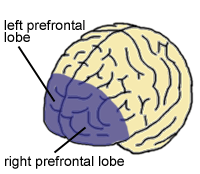Finally, a question where neuroscientists have found a pretty good answer! Learning happens when your brain strengthens the connections between specific cells. Here's one way this can happen.
Brain cells, or neurons, pass messages along to each other. Each neuron has receiving parts, called dendrites, and sending parts, called axons. A neuron sends a message down its axon, which passes the message on to the next neuron's dendrites. That neuron then sends the message down its axon along to the next neuron's dendrites. It's kind of like a game of telephone. Here is a picture of a neuron. All the lines that look like tree branches at the top are the dendrites, and the long line at the bottom that looks like the tree trunk is the axon.

The point where one neuron's dendrite reaches the next cell's axon is called a synapse. Communication happens when the first neuron's dendrite releases chemicals, called neurotransmitters, onto the second neuron's axon. Synapses are what change when you learn.
There are many ways that synapses can change. For one thing, you can grow more of them. Also, the axon can get more sensitive to the dendrite's neurotransmitters, or more neurotransmitters can be released... kind of like turning up the volume. More dendrites can also grow, which means more space for synapses to form. Especially when your brain is developing, axons can move around in your brain to find dendrites to form synapses with.
So how can you learn better? One way is to go over the same information more than once. Synapses are more likely to get stronger if they get stimulated repeatedly. Another way is to try to learn the information in the way that is best for you. Some people are better at learning things they read, some are better at learning things they hear, and some are better at learning things they talk about with other people. So for example, if you're a hearing learner, you could have someone read you your textbook, listen really well in class, or even make tapes to study from. And, in order to be the best you can at learning, you should always get plenty of sleep, exercise and play a lot, and eat healthy food.








